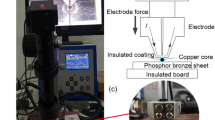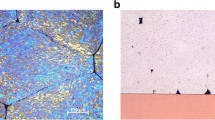Abstract
In order to confirm the failure mode and connection mechanism of parallel micro-gap resistance welding with 40 μm copper wire on 300 nm gold plated quartz substrate, the effect of heat input was discussed on bonding interface evolution. Wire bonding processes and their mechanical tests (tensile test and shear test) were carried out to analyze the failure modes. It is shown that the failure modes are bulk separation, partial separation, and melting at middle of interface, which deeply depend on the heat input. Too large a heat input can cause the copper wire and gold layer melt, while too small a heat input can not fully promote element diffusion of the bonding interface and lead to an unreliable connection. Simulation on wire bonding processes was carried out to propose the shape variation of copper wire and temperature distribution of bonding interface. With the increase of heat input, the bonding interface area increases significantly, and the thickness sharply decreases. The connection mechanism of bonding interface is changing from local plastic deformation, subsequent electro-migration to final melting. Meanwhile, the temperature at the bonding interface is exponentially increased, which is deeply related with the generation of intermediate phase. The micro-structure of bonding interface was observed to point out the reaction products. It is shown that the intermediate phases Au3Cu and AuCu are sequentially formed with the increase of temperature; however, the intermediate phase AuCu is corresponded with better connection performance.
Similar content being viewed by others
References
Zhong ZW (2009) Wire bonding using copper wire. Microelectron Int 26(1):10–16
Chauhan P, Zhong ZW, Pecht M (2013) Copper wire bonding concerns and best practices. J Electron Mater 42(8):2415–2433
Tian YH, Lum I,Won SJ, Park SH, Jung JP, Mayer M, Zhou Y (2005) Experimental study of ultrasonic wedge bonding with copper wire. In: proceeding of 6th International Conference on Electronics Packaging Technology, pp 389–393
Hong S, Hang C, Wang C (2005) Experimental research of copper wire ball bonding. In: Proceeding of 6th International Conference on Electronics Packaging Technology, pp 441–445
Tian YH, Wang CQ, Lum I, Mayer M, Jung JP, Zhou Y (2008) Investigation of ultrasonic copper wire wedge bonding on Au/Ni plated Cu substrates at ambient temperature. J Mater Process Technol 208(1):179–186. https://doi.org/10.1016/j.jmatprotec.2007.12.134
Tian YH, Wang CQ, Zhou Y (2008) Bonding mechanism of ultrasonic wedge bonding of copper wire on Au/Ni/Cu substrate. Trans Nonferrous Metals Soc China 18(1):132–137
Kim HG, Kim SM, Lee JY (2014) Microstructural evaluation of interfacial intermetallic compounds in Cu wire bonding with Al and Au pads. Acta Mater 64:356–366
Singh G, Haseeb ASMA (2016) Effect of pedestal temperature on bonding strength and deformation characteristics for 5N copper wire bonding. J Electron Mater 45(6):3244–3248. https://doi.org/10.1007/s11664-016-4403-y
Mo B, Guo Z, Li Y (2011) Mechanism of resistance microwelding of insulated copper wire to phosphor bronze sheet. Mater Trans 52(6):1252–1258
Shi W, Wang W, Huang Y (2016) Laser micro-welding of Cu-Al dissimilar metals. Int J Adv Manuf Technol 85(1–4):185–189. https://doi.org/10.1007/s00170-015-7925-1
Wan XD, Wang YX, Zhao DW (2016) Quality monitoring based on dynamic resistance and principal component analysis in small scale resistance spot welding process. Int J Adv Manuf Technol 86(9–12):3443–3451
Zhang WW, Cong S, Wen ZJ, Liu Y, Wang YS, Tian YH (2017) Experiments and reliability research on bonding process of micron copper wire and nanometer gold layer. Int J Adv Manuf Technol 92(9–12):4073–4080
Okamoto H, Chakrabarti DJ, Laughlin DE, Massalski TB (1987) The Au-Cu (gold-copper) system. J Phase Equilib 8(5):454–474. https://doi.org/10.1007/BF02893155
Funding
This paper was financially supported by NSAF Funding (No.U1730107). The authors would like to take this opportunity to express their sincere appreciation.
Author information
Authors and Affiliations
Corresponding author
Ethics declarations
Conflict of interest
The authors declare that they have no competing interests.
Rights and permissions
About this article
Cite this article
Cong, S., Zhang, W.W., Wang, Y.S. et al. Effect of heat input on failure mode and connection mechanism of parallel micro-gap resistance welding for copper wire. Int J Adv Manuf Technol 96, 299–306 (2018). https://doi.org/10.1007/s00170-018-1596-7
Received:
Accepted:
Published:
Issue Date:
DOI: https://doi.org/10.1007/s00170-018-1596-7




